A Quote From the First Prime Minister of Israel David Ben-Gurion
Comprising sixty percent of the land space in
Israel, one might think the Negev Dessert an important and heavily inhabited area of the country. Ben Gurion (the fist prime minister of Israel) thought the Negev needed to be conquered and turned into productive agricultural land with a multitude of cities to allow for all the the immigrants Israel would accept in the coming years. The title quote of this post was taken from the opening speech he gave at Ben Gurion University in the northern Negev. Unfortunately for Ben Gurion, and many could argue for Israel most of the Negev is still unconquered while
Tel Aviv overflows with citizens and immigrants to the point that housing in the city is becoming increasingly unaffordable.
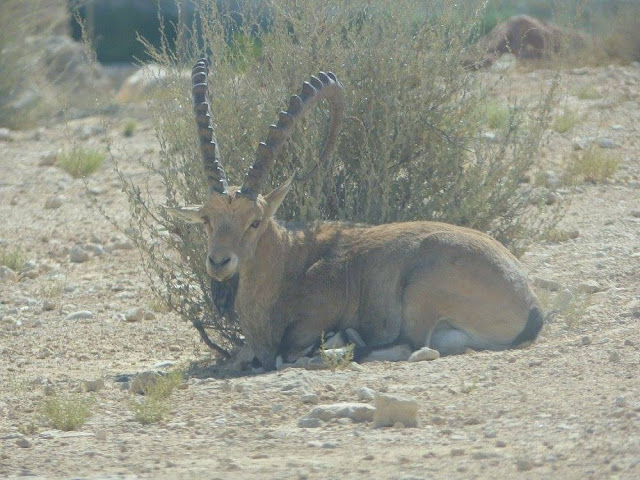 |
An ibex outside the Maktesh Ramon Visitor's Center.
|
The Negev remains a place untethered, and is home to various kibbutzes (agricultural-based communist communities) and national parks. We took a day to drive around the Negev dessert, taking in the vistas, learning about natural history, and exploring a hidden oasis. Our first stop was at Maktesh Ramon.
Maktesh is the Hebrew term for "crater" which is not exactly what these features are. These crater shaped canyons that litter the Negev were formed by a combination of uplifting rock, kind of like how mountains are formed, followed by fluvial erosion (erosion by rivers). The resulting canyon looks kind of like a crater, although it was not formed by a meteor impact or volcanic eruption. Some of these makteshes are huge. Maktesh Ramon is the largest and is so huge standing on one edge of it, the opposite edge cannot be seen.
Today Maktesh Ramon is a national park and home to a variety of critters, some of which we were able to see upclose in an animal rehabilitation center near the Maktesh Ramon visitor's center. While most Israelis are opposed to settling in the Negev, porcupines, snakes, turtles, chameleons, ibexes, gazelles, and more species of rodents than sides of a die call the Negev home.
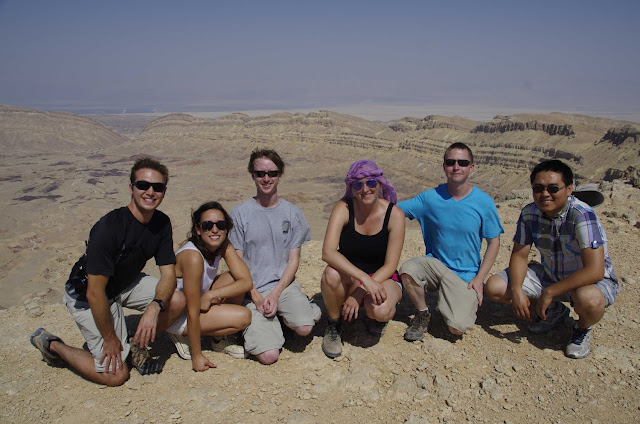 |
| Kneeling in front of the small maktesh (crater) behind me with friends. The small maktesh is still quite large. |
While Maktesh Ramon is the largest of the makteshes, we also visited two other Makteshes on our day trip: Small Maktesh and Large Maktesh. Small Maktesh was the only one small enough to fit into a single photo which shows the crater-like shape of the formation. Makteshes are not the only national parks in the Negev. One other park we stopped at was Ein Avdat, an oasis in the desert.
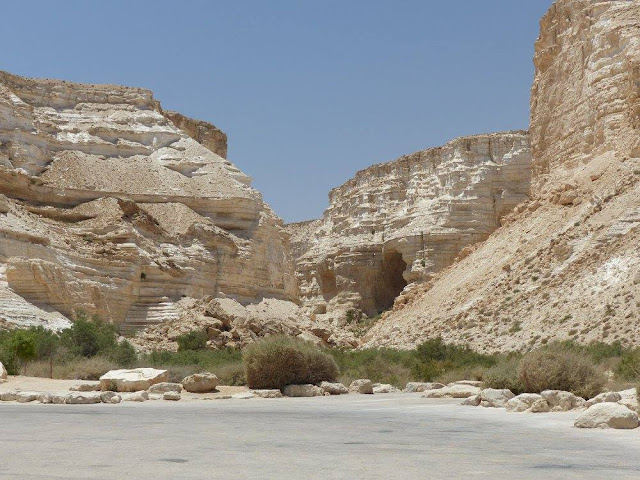 |
| The canyon of Ein Avdat, hiding the oasis within. |
Ein Avdat is a canyon cut into the sediment below by a very small spring fed stream. It's undoubtedly beautiful with steep walls and still green water through which freshwater crabs scurry. In reality hiking through that park was probably the hottest I've was in Israel and the water was trepid and full of bugs. I am sure the ancient travelers were relieved to see water after long days of riding camels through the desert, but I hope they were smart enough to filter the water though cloth and boil it before drinking, because that water was nasty. Signs are posted at the entrance telling visitors not to swim in the spring. I may have been super hot, but unless the walls of the canyon were on fire, I was not going in that spring.
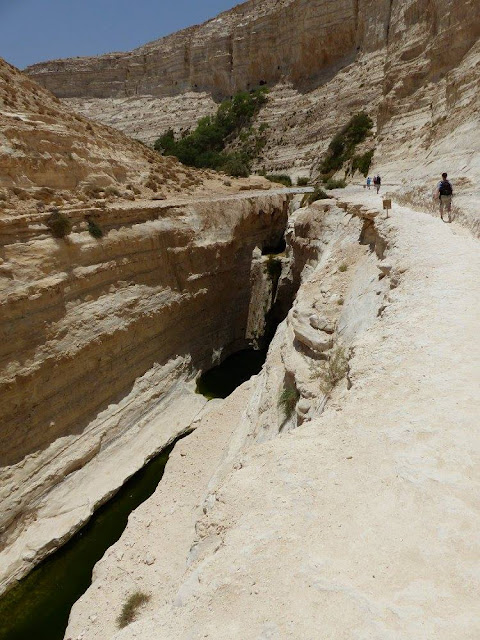 |
| Hiking on the cliffs above the Oasis below. |
Near Ein Avdat is Ben Gurrion's tomb, also a national park. Ben Gurrion was an integral part of modern day Israel's formation and was afforded respect by having his tomb so well preserved in the desert he loved so much. We're not Israeli so we skipped it.
 |
| The spring at the end of the Ein Avdat Canyon. Most of my group collects at the end near a small waterfall. |
The Negev desert is filled with cool sights hiding amongst the shrubs and hills. Our tour guide showed us a cistern built by the Nabateans, the same civilization that built
Petra. The cistern lined with plaster and linked to an advanced water catchment system was built so well, it still works thousands of years later. Fortunately it was dry when we visited, allowing us to explore the expanse of it.
 |
| An ancient cistern hidden in the desert, built by the Nabateans to catch runoff during the winter floods. |
Like the rest of
Israel, there are many archeological sites relating to the history of the Israeli people in the Negev. One we didn't have time for is the ancient site of Be'er Sheva, meaning seven wells. Be'er Sheva was founded by Abraham who was told about it by God. Adjacent to the modern large city visitors can walk among the ancient ruins of the first civilization. Other points of interest I did get to visit in the Negev include the Hai Bar Wildlife Refuge and Safari and
Timna Park (home of the world's oldest copper mines) both of which I highly recommend.
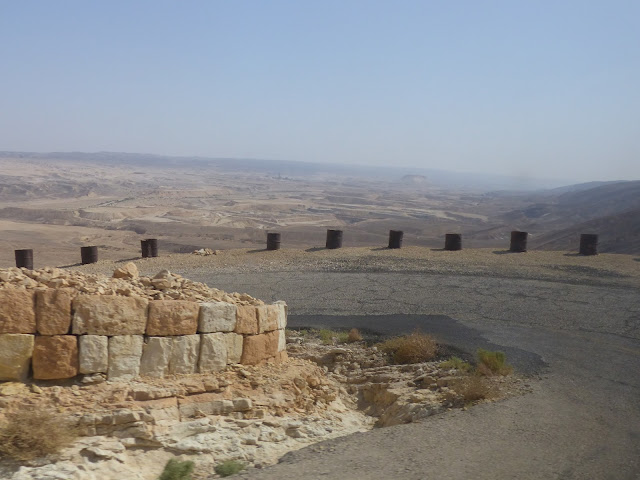 |
| Coming up on a tight turn on the Scorpion's Descent. I did not take the photo as I was driving and those barrels would not prevent the van from flying over the edge. |
One more thing unique to the Negev are its ancient roads that descend into the rift valley south of the
Dead Sea. This rift valley contains the main road and easiest travel to the Red Sea. Descending down into the rift valley, visitors are presented with a number of options. Aside from the modern road built by the modern Israeli government, there is a descent built by the Romans (now a hiking trail), and the British in the early 1900s. So people have been trying to conquer the Negev long before Ben-Gurion encouraged the modern Israeli government to do so.
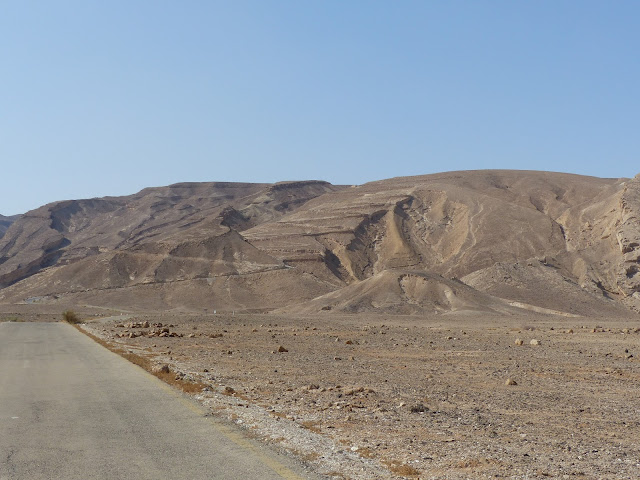 |
| The zig-zagging road of the scorpion's descent into the rift valley from Be'er Sheva to the Red Sea. |
The fastest way down to the main road of the rift valley from the Small Maktesh and our last stop of the day, was the Scorpion's Descent built by the British about one hundred years ago. This descent consists of a winding single lane road for about a mile before repetitions of switch backs, lined with barrels in a lame attempt to prevent cars from careening off the road. I was the lucky driver who glided our massive mini van down the cliff side and into the valley, after which I switched drivers sitting in the back with a cold drink for the rest of the drive back.





No comments:
Post a Comment